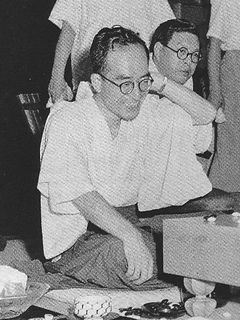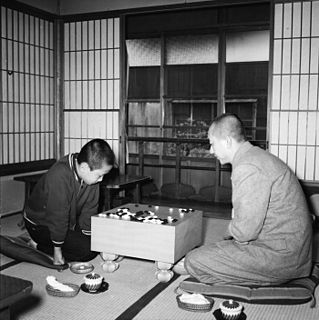Related Research Articles

The Nihon Ki-in (日本棋院), also known as the Japan Go Association, is the main organizational body for Go in Japan, overseeing Japan's professional system and issuing diplomas for amateur dan rankings. It is based in Tokyo. The other major Go association in Japan is Kansai Ki-in. Its innovations include the Oteai system of promotion, time limits in professional games, and the introduction of issuing diplomas to strong amateur players, to affirm their ranks.
Hon'inbō Shūsai is the professional name of Hoju Tamura, also known as Yasuhisa Tamura, who was a Japanese professional Go player.
The Kansai Ki-in (関西棋院), i.e., Kansai Go Association, is an organizational body for the game of Go in Japan, which was founded by Hashimoto Utaro in 1950. Though it is not as large as its chief rival, the Nihon Ki-in, it also issues diplomas to strong players and oversees professionals as the Nihon Ki-in does.

Kaku Takagawa, also known as Shūkaku Takagawa, was one of the most successful professional Go players of the twentieth century.

Cho Chikun25th HoninboHonorary Meijin is a professional South Korean Go player and a nephew of Cho Namchul. His total title tally of 75 titles is the most in the history of the Japanese Nihon Ki-in. Cho is the first player to hold the top three titles—Kisei, Meijin, and Honinbo—simultaneously which he did for three years in a row. Cho is the first in history to win all of the "Top 7" titles in Japan which he achieved by winning the Oza in 1994. Cho U in 2011 and Iyama Yuta in 2013 would duplicate this feat, both by winning the Kisei. He is also one of the 'Six Supers' Japanese players that were most celebrated in the late twentieth century, along with Rin Kaiho, Otake Hideo, Takemiya Masaki, Kato Masao and his classmate and arch-rival Kobayashi Koichi. He is the author of several books on Go.

Rin Kaihō or Lin Haifeng is a professional Taiwanese Go player who made his name in Japan. He is, along with Cho Chikun, Kobayashi Koichi, Otake Hideo, Takemiya Masaki and Kato Masao, considered one of the 'Six Supers' that dominated Japanese Go world in the last three decades of the twentieth century.

Eio Sakata was a 9-dan Japanese professional Go player.
Keigo Yamashita is a professional Go player. Yamashita adopted the name Honinbo Dowa after winning his first Honinbo title in 2010.
Cho Sonjin is a professional Go player.
Kaoru Iwamoto, also known as Honinbo Kunwa, was a Japanese professional Go player and writer who achieved the rank of 9-dan.
The Hoensha was a Japanese Go organization founded in 1879 by Honinbo Shuho. The Hoensha was the successor to study groups set up by Nakagawa Kamesaburo and other players. It was the major Go organization of the later Meiji period. Like the many Go organizations today, the Hoensha awarded professional grades. The Hoensha house magazine was Igo Shinpo. The Four Heavenly Kings of Hoensha were Kobayashi Tetsujiro, Mizutani Nuiji, Sakai Yasujiro, and Takahashi Kinesaburo. The Three Wunderkinder were Ishii Senji, Sugioka Eijiro, and Tamura Yasuhisa. When Nihon Ki-in was established, the Hoensha was dissolved in 1924.
Karigane Jun'ichi was a Japanese professional Go player, posthumously made an honorary 9 dan by the Nihon Ki-in.
Maeda Nobuaki was a Japanese professional 9 dan go player, a disciple of Honinbo Shusai, and a member of the Nihon Ki-in, the main organizational body for go in Japan. His own disciples were Norio Kudo, Yusuke Oeda, Shioiri Itsuzo, Nagahara Yoshiaki, and Morikawa Masao.
Dohei Takabe was a professional 7 dan Go player.
Chiyotaro Onoda was a professional 7 dan Go player.
Tamejiro Suzuki was a professional 8 dan Go player.
The 18th Agon Cup began on 21 April 2011 – 1 October 2011. Two Korean amateur players were invited to the preliminaries, with both qualifying. Ha Sungbong defeated professionals Yanigasawa Satoshi and Furuya Yutaka. Kim Sungjin defeated 25th Honinbo and Japan's top title holder Cho Chikun. He also defeated Kato Atsushi. In the main tournament, he was knocked out by Iyama Yuta Meijin in the first round. Iyama Yuta came out as the winner. He beat Yamashita Keigo at the final. The winner's prize was ¥10,000,000.
Hsieh Yimin is a Taiwanese-born professional Go player in Japan. She holds the titles of Honorary Female Honinbo and Honorary Female Meijin, and currently holds three major female titles in Japan: Female Meijin, Female Kisei and Female Honinbo.

Rina Fujisawa is a Japanese professional Go player.

Shibano Toramaru is a Japanese Go professional who won the prestigious Meijin tournament in 2019 at age 19, becoming the first teenager to achieve one of the seven major Japanese titles.
References
- 1 2 "Nihon Ki-in announces Go Hall of Fame" . Retrieved 2010-02-12.
- ↑ "Most recent induction" . Retrieved 2010-02-12.